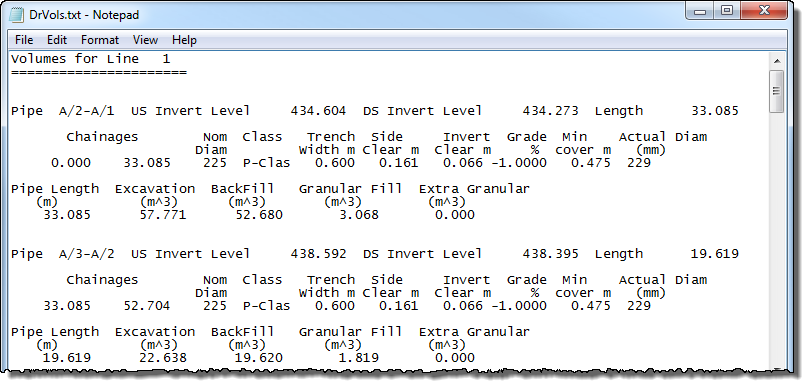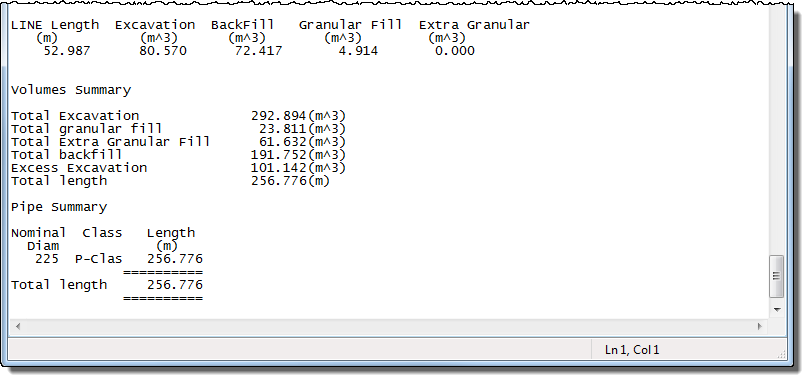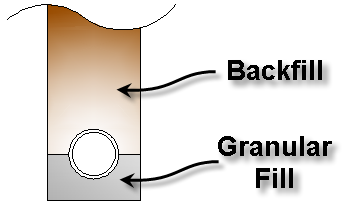Trench Volumes Report
| Icon: |
|
| Menu: | Pipes > Reports > Trench Volumes |
| Ribbon: | Pipes Tab > Reports Panel > Trench Volumes Report |
Introduction
This command is used to calculate trench volumes associated with the creation of the pipe networks.
A simple trench shape is assumed with vertical walls - the trench width and bottom are defined by the Pipe Type in the Active Network Settings with the specification of side and bottom offsets from the outside edge of each pipe type.
By default the software assumes all pipes in a network have crushed rock backfill. This command enables a section, or the full length, of a pipe to be identified for standard (earth) backfill.
Two (2) types of backfill are currently included in the software:
| Default (Crushed Rock) Backfill
|
Standard (Earth) Backfill
|
| 'Crushed rock' is assumed (vertically) from the centre of the pipe up to the sub-grade level under the pavement. From the bottom of the trench to the centre point of the pipe the material is separately quantified. |
'Standard' backfill is assumed (vertically) from the centre of the pipe up to the surface level. From the bottom of the trench to the centre point of the pipe the material is separately quantified. |
Standard backfill is defined using the Set Pipe Backfill Lengths command.
Note: The volume calculations assume pipe lengths to the centre of structures.
Details
Upon selecting this command, the designer must select a network for a volume report. This can be achieved by either selecting the network in the drawing or from a list. Click here for more details on selecting a network.
After selecting a network the following form is displayed:
 This form allows the designer to set a depth for the road pavement subgrade - this depth is omitted from the trench volume calculations. Form details are as follows: |
|
| Enter Subgrade Depth | Type in the depth to the bottom of the road pavement. The same depth is assumed across the pipe network. |
| OK | Exit and create a report. |
| Cancel | Exit without creating a report. |
Upon clicking OK the report is a file "DrVols.txt" is created and will open in Notepad.
If it does not appear, it can be viewed by selecting it from the Windows taskbar.
A sample report follows:
  |
|
| Volumes for Line # | This identifies each branch of the network. Each pipe is identified including the volumes. |
| Pipe ID, US/DS Invert Level, Length | Identifies the pipe and geometry. |
| Pipe Details | Pipe details include: Chainages, Nominal Diameter, Pipe Classes, Trench Width, Side Clearance, Invert Clearance, Grade, Minimum Cover and Actual pipe diameter. |
| Pipe Volumes | Pipe length, excavation volume (material removed), Backfill (earth backfill), Granular Fill (material from the trench bottom to the centre of the pipe), Extra Granular (crushed rock backfill). |
| Volumes Summary | The summary give overall volume materials for the network. |
| Total Excavation | Total volume of material removed from the trench/es. |
| Total granular fill | Total volume of material between the bottom of the trench/es and pipe centreline/s. |
| Total Extra Granular Fill | Total volume of crushed rock material required (excluding Total Granular Fill) for the trench/es. |
| Total Backfill | Total volume of 'standard' (earthen) backfill material required (excluding Total Granular Fill) for the trench/es. |
| Excess Excavation | Excavated material that will not be re-used in trench backfilling. |
| Total length | Total length of network (pipe-to-pipe). |
| Pipe Summary | This summary gives the overall list of pipe types used and total lengths of pipe used (measured to the centre of structure). |
| Nominal Diameter, Class, Length | For each pipe diameter and class, lists the total length of pipe used. |
| Total granular fill | Total volume of material between the bottom of the trench/es and pipe centreline/s. |

